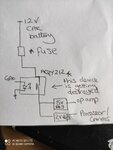Rajinder1268
Full Member level 3
Hi all,
I have a circuit which is powered from 12V car battery. The circuit keeps getting destroyed it has a regulator 5V and opamp. How can I protect this from transients, which I assume is damaging the electronics. Is a TVS diode a good solution?
How would I select one?
Thanks in advance
I have a circuit which is powered from 12V car battery. The circuit keeps getting destroyed it has a regulator 5V and opamp. How can I protect this from transients, which I assume is damaging the electronics. Is a TVS diode a good solution?
How would I select one?
Thanks in advance

